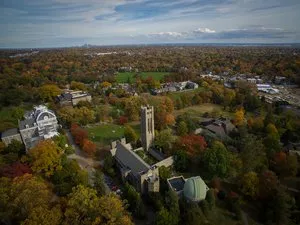Doctorates Awarded
Each year the National Science Foundation (NSF) conducts the Survey of Earned Doctorates. Each person who has earned a research doctoral degree that year is surveyed, and among the questions asked are the field in which the doctorate was earned, and the Baccalaureate institution that the recipient had attended. The doctoral-granting institution is responsible for submitting the surveys, and consequently NSF has very good data on this. These data are made available to the public through publications and online via the National Center for Science and Engineering Statistics (NCSES).
The table below presents data for a recent 10-year window. Doctorates awarded between 2013 and 2022 to graduates of each baccalaureate institution are presented as a proportion of the number of bachelor's degrees awarded in a lagged (by nine year — 2004-2013) period.
Swarthmore produced doctorates at a rate of 21.8% overall (3rd highest), and 15.4% in Sciences and Engineering (5th highest).
| Institution Name | All Disciplines | Science and Engineering | ||
| Rate | Rank | Rate | Rank | |
|
California Institute of Technology |
40.5% |
1 |
39.6% |
1 |
|
Harvey Mudd College |
28.9% |
2 |
28.2% |
2 |
|
Swarthmore College |
21.8% |
3 |
15.4% |
5 |
| Massachusetts Institute of Technology |
19.5% |
4 |
18.7% |
3 |
|
Reed College |
19.4% |
5 |
14.4% |
6 |
| Carleton College |
17.9% |
6 |
13.8% |
7 |
|
Franklin W Olin College of Engineering |
17.3% |
7 |
16.8% |
4 |
|
University of Chicago |
16.5% |
8 |
12.0% |
10 |
|
Haverford College |
16.1% |
9 |
12.2% |
8 |
|
Grinnell College |
15.9% |
10 |
12.1% |
9 |
|
Pomona College |
15.1% |
11 |
11.8% |
11 |
|
Williams College |
14.4% |
12 |
10.4% |
14 |
|
Princeton University |
14.3% |
13 |
11.2% |
12 |
|
New College of Florida |
13.9% |
14 |
10.0% |
15 |
|
Yale University |
13.0% |
15 |
8.7% |
18 |
|
Harvard University |
13.0% |
16 |
9.3% |
17 |
|
Bryn Mawr College |
12.6% |
17 |
7.9% |
27 |
|
Rice University |
12.4% |
18 |
10.4% |
13 |
|
Amherst College |
12.3% |
19 |
8.6% |
21 |
|
Oberlin College |
12.2% |
20 |
7.4% |
34 |
|
St. John's College |
12.0% |
21 |
6.3% |
52 |
| Bard College at Simon's Rock |
11.8% |
22 |
7.6% |
31 |
|
Brown University |
11.7% |
23 |
8.6% |
20 |
|
Macalester College |
11.4% |
24 |
7.9% |
26 |
|
Wellesley College |
11.3% |
25 |
8.1% |
24 |
Printable list of the top 100 institutions [pdf]
A listing of the top 100 baccalaureate producers of doctorates in each of the 8 broad discipline fields during this period may be found here [pdf]. (Note, this document is 22 pages long.)
Researchers use the NSF data in various ways to reflect the "Baccalaureate Origins" of doctoral degree recipients. Sometimes raw numbers of doctorates awarded to graduates of an institution in a given year or years are presented. An example of this is "Doctorates Awarded to Graduates of Liberal Arts Colleges, FY 2022" [pdf] in Swarthmore's Fact Book. This table presents the numbers of doctorates earned in 2022 (only), by field, by graduates of Liberal Arts institutions.
Sometimes, as in the table above, the figure is presented as a rate by dividing the raw number in a given time period by the number of bachelor's degrees awarded in an appropriate lagged time period. (This is sometimes called "weighted doctorates" because the doctorates are weighted by some measure reflecting the size of the baccalaureate institution.) For the presentation above, the Swarthmore College Office of Institutional Effectiveness, Research & Assessment extracted data files from NSF using the NCSES Interactive Tool, and merged them with completions data from NCES (IPEDS Data Center) in order to perform necessary calculations to sum and weight doctorates overall and in broad fields. Numerous research projects and published articles have used this approach to demonstrate the strength of Liberal Arts Colleges in graduating students who go on to earn doctorates. When the rate is calculated for all institutions and then ranked, the top of the list is dominated by Liberal Arts Colleges, such as Swarthmore, and not by the major research universities that one might expect. Swarthmore College often appears near the top of these ranked lists, the exact position depending on the time frame used, the weighting scheme, or the fields of study of interest. This means that Swarthmore graduates a relatively high number of students who go on to earn doctoral degrees.



